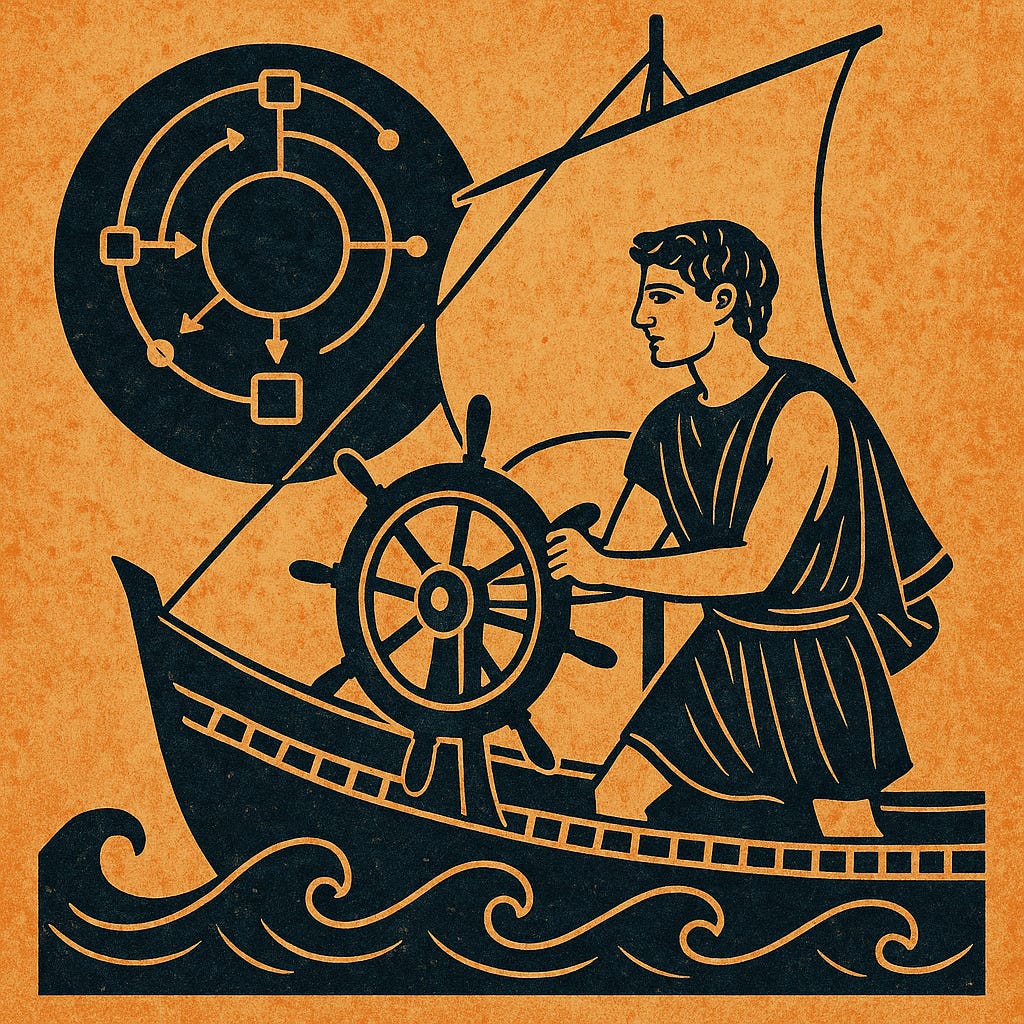Telemachus' A–N–R Core
A Distilled Theory Card
An enclosing inside and an external environment.
Variety absorbs variety (Ashby’s law of requisite variety).
Minimize free energy; maximize free entropy (min F, max S₍free₎) → maintain coherence and creative potential.
Between stasis and chaos (avoid both pathologies; Kauffman’s edge of chaos).
Two “trivial” machines A and N (each 1st-order cybernetics / Bayesian, non-Markov).
Exploit and explore: adaptive A and normative N; attention and counterfactual negation.
Averaging (openness to change) and (re)Normalization (closure for coherence) — together balancing cognition.
Coupled by the R(otation)-rule (second-order Bayes with phase θ; quantum-like but not quantum). R for Rotation, Reflexivity and Recursion.
Learning heartbeat: Both A and N learn by TD on different rhythms (inner/outer loops);
add MCTS for counterfactuals (shallow for A, deeper for N), and use evolutionary population search to expand safe variety for N. Bellman’s expectation in recursive form.
Noise enables learning and drift, but A and N correct each other (exploration ≈ error).
A stable core within N ⇒ self (homeodynamic identity manifold).
Control of control (von Foerster’s second-order cybernetics).
The R-rule is recursive → third-order coupling and meta-learning possible.
A space of opposites in tension (thirst ↔ hunger, wakefulness ↔ sleep, agency ↔ control …)
as non-collapsible axes where tension = surprise = probability = error.
Probabilities represented as random bit-strings (AND ≈ joint, concatenation ≈ log-evidence). Suppes’ model-theoretic homomorphism makes the mapping from world to model testable. *
1 : 1 homomorphism with physics / biology (energy ↔ information flow, metabolism ↔ computation). *
Stochastic differential equations can describe the dynamics; drift and diffusion encode adaptation.
Trace ψ = R(θ)[A,N] — the momentary resolution and temporal grounding; it feeds back to update A (evidence) and N (norms), accumulating as non-Markov memory.
Autopoietic and testable: continuous self-production of boundary and organization (Maturana & Varela).
Expands beyond any observer’s frame (von Foerster’s non-trivial machine) → creative unpredictability. Trickster WARNING!
Unless trivialized by constraints — safety via bounded norms and budgets. *
ψ′= ψ + η(p(1−p))^1/2 * [αsinθ A(a, ψ) − iβcosθ N(a, ψ)], p(a)=∣ψ(a)∣^2/ ∑b ∣ψ(b)∣^2
Notes
Ashby → Suppes → von Foerster → Maturana & Varela → Prigogine → Kauffman → Friston: lineage of regulation, representation, reflexivity, self-production, thermodynamics, criticality, and predictive closure.
* marks implementation-level clarifications answering the “it’s just maths” reflex — how physical, biological, and computational realizations remain formally homomorphic.
Developed for an AI Odyssey (with but not by ChatGPT-5). Maybe some day it will pop out *
Lineage
Ashby (1956): requisite variety → internal complexity = survival.
Suppes (1957–1971): model-theoretic empiricism → probabilistic mapping between data & theory.
von Foerster (1959–1979): trivial ↔ non-trivial machines → observer inclusion, reflexivity.
Quantum formalism (1940s–): stochastic 2nd-order mathematics → superposition, interference, and phase dynamics later generalized to nonlinear probabilistic systems. (Born, Schrödinger, Wiener; the mathematics, not the metaphysics.)
Maturana & Varela (1980): autopoiesis → self-producing systems.
Prigogine (1980): dissipative structures → order through non-equilibrium flow.
Kauffman (1993–2000): edge of chaos → emergence of novelty & adjacent possible.
Friston (2010–): free-energy principle → unified perception, action, and learning.



